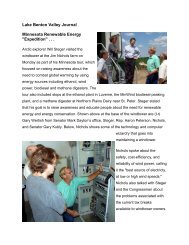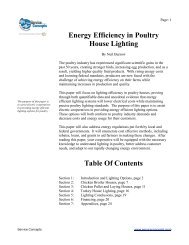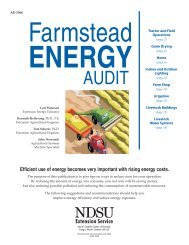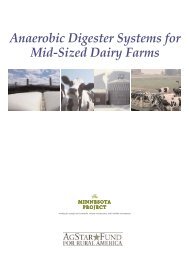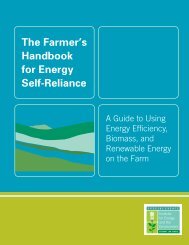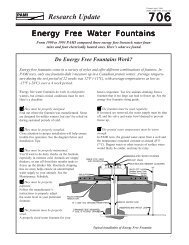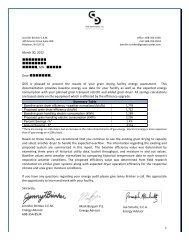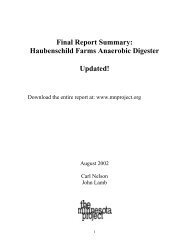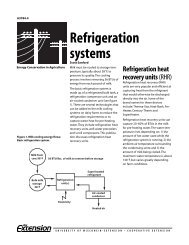Dairy Farm Energy Management Handbook - Wisconsin Department ...
Dairy Farm Energy Management Handbook - Wisconsin Department ...
Dairy Farm Energy Management Handbook - Wisconsin Department ...
You also want an ePaper? Increase the reach of your titles
YUMPU automatically turns print PDFs into web optimized ePapers that Google loves.
Lighting professionals in the field report that red is not clearly<br />
distinguishable from brown under low CRI high-pressure sodium lights.<br />
This means that bloody discharges may not be recognizable under highpressure<br />
sodium lights.<br />
Mercury vapor lights give off a bluish light and have been commonly<br />
used as yard lights; however, they are not recommended for dairy<br />
facilities because of low efficiency, and the CRI values range from 15 to<br />
50%. The bottom line is that you have other and more efficient options<br />
than mercury vapor lights.<br />
• Compact fluorescents: Compact fluorescent lights (CFL) can be used<br />
to replace incandescent lights when the existing fixture meets the<br />
National Electric Code safety requirements for livestock buildings. CFLs<br />
are not very tolerant of high moisture conditions and should be housed<br />
in a water resistant enclosure if used in a farm building. T8 Linear<br />
fluorescent lights provide the best life cycle cost option for new<br />
construction because of higher efficiency and longer bulb life.<br />
In the Recommended Illumination chart, you’ll find a more detailed<br />
breakdown of suggested lighting levels for various areas in a dairy<br />
facility.<br />
• Keep Lights Clean: It usually doesn’t take too long before the normal<br />
airborne dust and dirt in dairy facilities begin clinging to lamp fixtures<br />
and robbing the original intensity of your lighting.<br />
Like a magnet, electrostatic forces within a<br />
light fixture are also at work in attracting<br />
those dirt particles and causing significant<br />
dirt build-up over time.<br />
There’s a fancy term for this dirt build-up on<br />
lights, and some researchers are beginning<br />
to look at ways to put a number on it for<br />
dairy facilities. It’s called Luminaire Dirt Depreciation (LDD). The impact<br />
of flies on lights is also being examined.<br />
While some light manufacturers have data on LDDs for residential,<br />
commercial, and industrial settings, no similar information exists for<br />
dairy facilities. Presently, designers must use data from these<br />
applications and try to match it as best as possible with the environment<br />
in dairy barns.<br />
Researchers at Cornell University and DL Tech, of New York, are doing<br />
field studies at dairy facilities to calculate the specific impact of dust, dirt<br />
and flies on light illumination.




